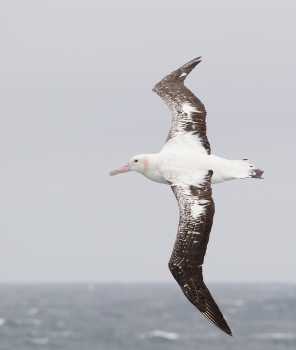Rémi Fay (Centre d'Etudes Biologiques de Chizé, Villiers-en-Bois, France) and colleagues have published in the journal Functional Ecology on how climate and population density effect Wandering Albatrosses Diomedea exulans at different stages of their lives.
The paper’s abstract follows:
“1. Although population responses to environmental variability have been extensively studied for many organisms, few studies have considered early-life stages owing to the inherent difficulties in tracking the fate of young individuals. However, young individuals are expected to be more sensitive to environmental stochasticity owing to their inexperience and lower competitive abilities. Thus, they are keys to understand demographic responses of an age-structured population to environmental variability.
2. In this study, we used capture-recapture modelling, based on a 49 year-long individual-based longitudinal monitoring dataset, to investigate climatic and population density effects on immature demographic parameters in a long-lived seabird, the wandering albatross.
3. We provide evidence that climate and population size affected both survival and recruitment age of young individuals although in different ways according to the trait. We found that early-life survival was mainly affected by population density, whereas recruitment age variation appeared to be better explained by climatic conditions, with a surprising long-term effect of climate. While population size explained 60% of the variation in juvenile survival, average Southern Annular Mode over the five previous years explained 52% of variation in recruitment age.
4. Additionally, although early-life survival was consistently negatively affected by population size, the relationship between recruitment age and population size shifted from negative to positive over time from the 1970s to 2000s, showing that density dependence mechanisms can temporarily disappear.
5. Finally, we found that similar climatic conditions may affect individual performances in opposite ways according to the life stage of individuals. This result underlines the critical need to assess age specific functional responses to environmental variability to allow accurate demographic predictions. By revealing the poorly known demographic process of younger age classes, the results of this study improve our understanding of population dynamics of long lived marine species.”

Wandering Albatross at sea, photograph by John Chardine
Reference:
Fay, R., Barbraud, C., Delord, K., & Weimerskirch, H. 2017. Contrasting effects of climate and population density over time and life-stages in a long-lived seabird. Functional Ecology DOI: 10.1111/1365-2435.12831.
John Cooper, ACAP Information Officer, 30 January 2017

 English
English  Français
Français  Español
Español